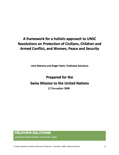|
Influence on the Ground: Understanding and strengthening the protection impact of United Nations human rights field presences, Liam Mahony and Roger Nash, 2012
|
Influence on the Ground is a 2012 study by Fieldview Solutions aimed at understanding and strengthening the protection impact of United Nations human rights field presences.
The deployment of human rights officers in the field is one of the most important tools the United Nations has to protect human rights. But the role and power of these human rights field presences are often misunderstood, oversimplified and underestimated.
|
 |
||
|
Non-military Strategies for Civilian Protection in the DRC, Liam Mahony, 2013 |
This think piece identifies gaps and flawed assumptions in the current protection response in the Democratic Republic of Congo (DRC) and suggests ways in which the international community can improve its impact. International actors put too much emphasis on short-term responses to the needs of victims of violence, while insufficient resources and creativity are applied to preventing violence and solving the problems causing that violence. A range of unarmed strategies and activities are proposed to humanitarian and other non-military actors to influence armed actors and reduce the violence.
|
 |
||
|
Fieldview Solutions recently carried out a review of the work of the Norwegian Refugee Council during the closing phases of the Sri Lankan civil war. This study examined the dilemmas faced by NRC in dealing with the prolonged internment of IDPs by the Sri Lankan government. The full version remains confidential to NRC but an abridged version is available here.
|
 |
|||
|
A framework for a holistic approach to UNSC Resolutions on Protection of Civilians, Children and Armed Conflict, and Women, Peace and Security, Liam Mahony and Roger Nash, 2008 |
Prepared for the Swiss Mission to the United Nations in New York, this report analyses the complementarity and gaps in current UNSC efforts to address protection of civilians in armed conflict, with a particular focus on how UNSC action traverses the international system to ultimately impact on the ground. |
|||
|
|
||||
|
Proactive Presence: Field strategies for civilian protection, Centre for Humanitarian Dialogue, Liam Mahony, 2006 |
Proactive Presence is the result of a three-year research project into the protective impact of deploying unarmed international staff into conflict zones. Based on analysis of nine missions and hundreds of interviews, it is the first comprehensive study of its type. |
|||
|
Unarmed Bodyguards: International accompaniment for the protection of human rights, Liam Mahony and Luis Enrique Eguren, Kumarian Press, 1997
|
Unarmed Bodyguards is a study of the tactic of unarmed accompaniment, focussing on its use in Latin America in the 1980s and 1990s. This study looks at the theoretical and practical aspects of the use of international presence to increase political space under repressive regimes. "There are many lessons here of great significance, if we choose to learn them." --Noam Chomsky |
|||
| Demarcation between Military and Humanitarian Activities in Afghanistan and the Role of Law, Roger Nash, Essex Human Rights Review Vol. 4 No. 2, September 2007 | A study of the structural failure in post-2001 Afghanistan to adequately distinguish between security and reconstruction tasks and the implications this had for the provision of relief by non-governmental actors. | |||



